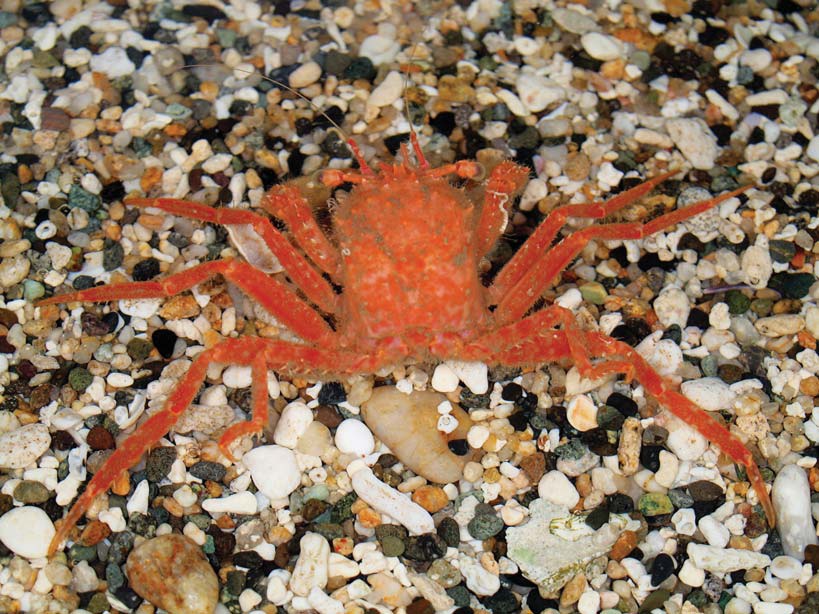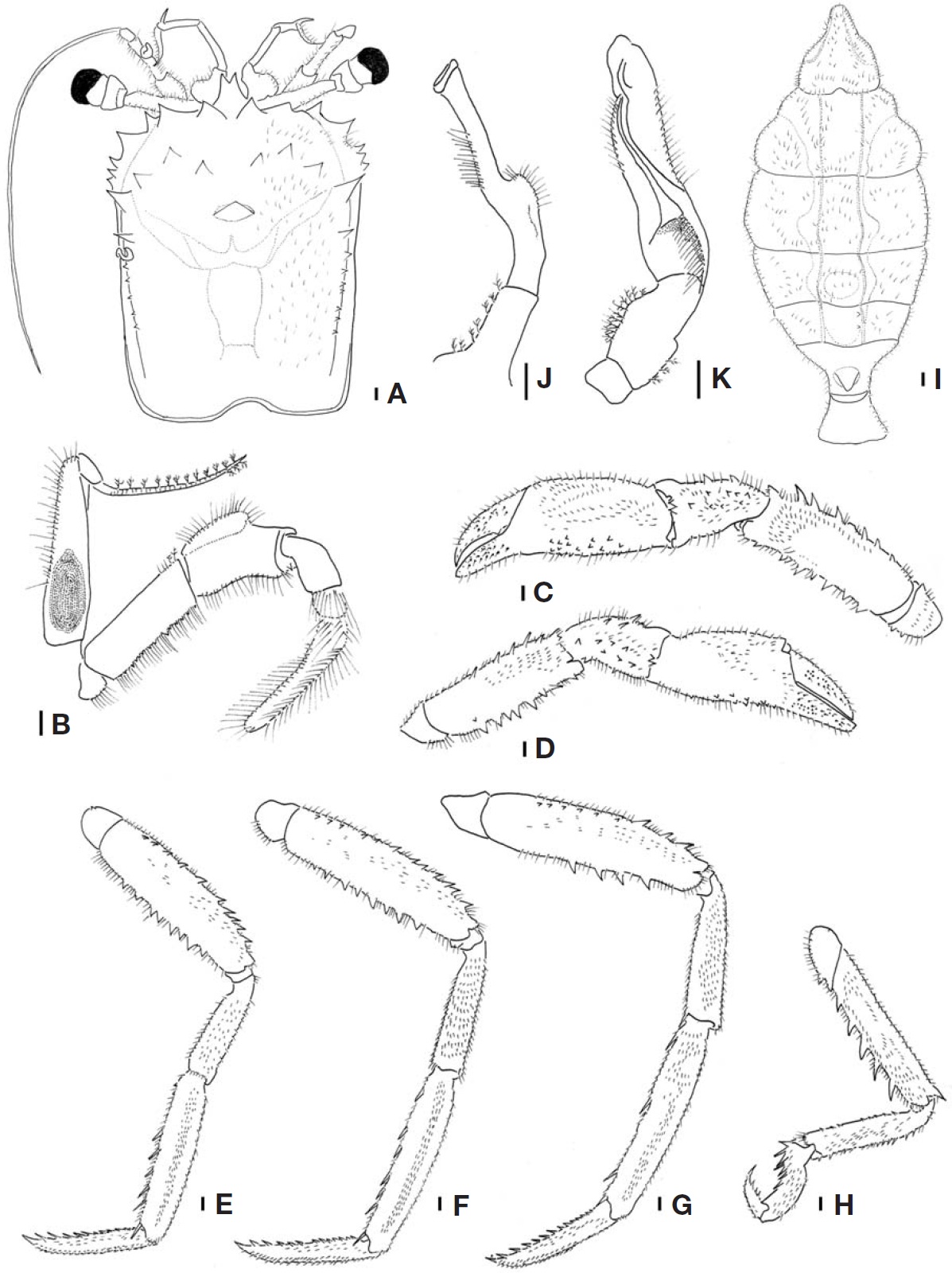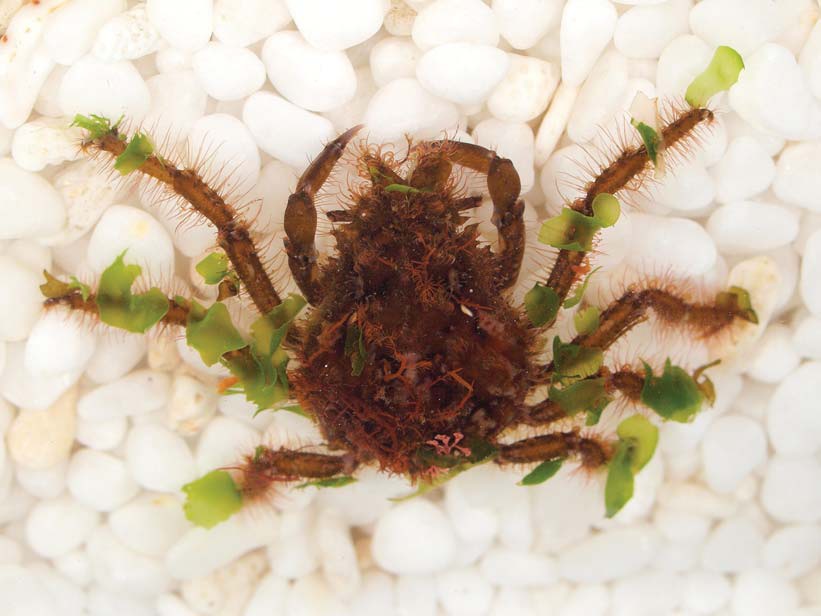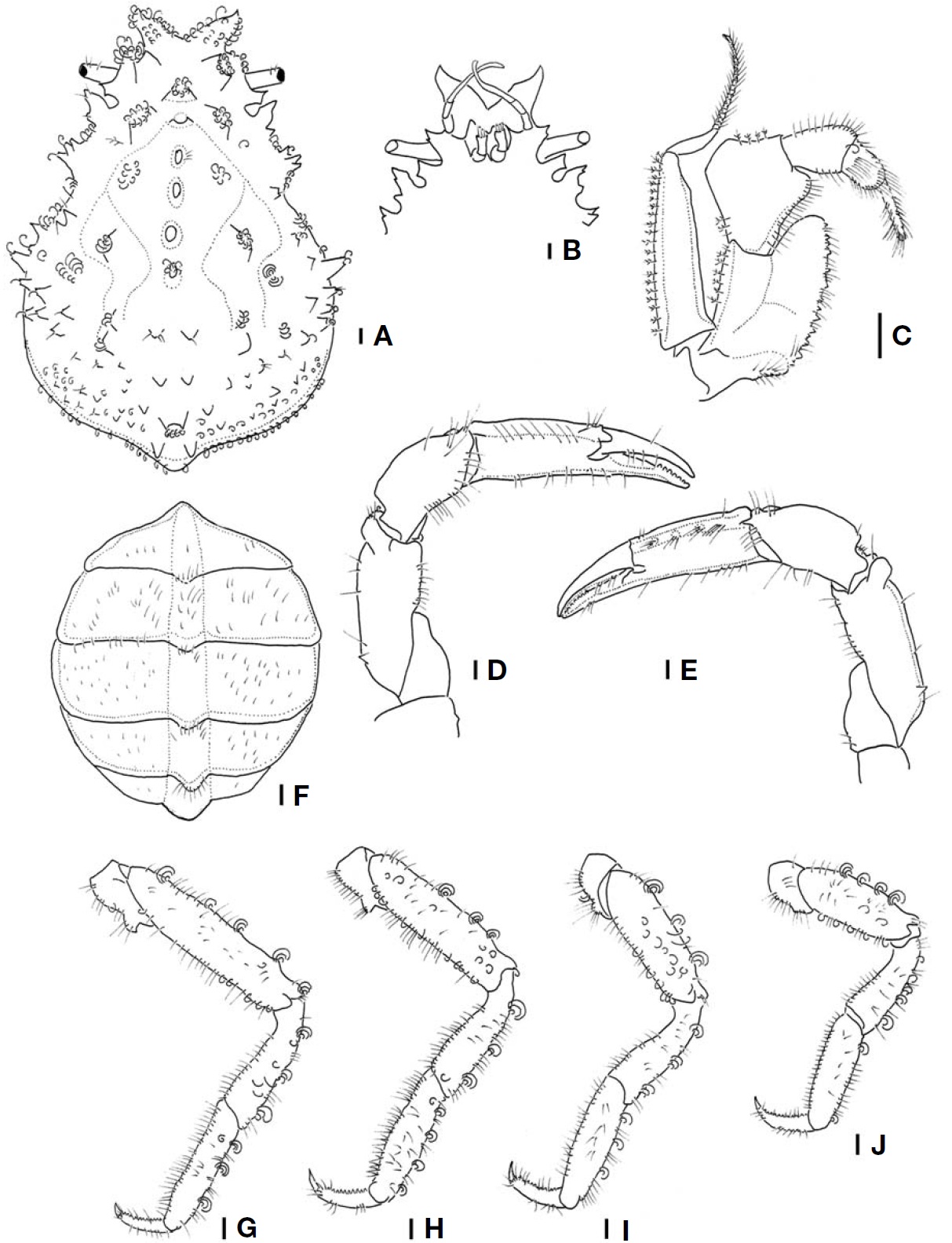



Two species of crabs, Homola orientalis Henderson, 1888 and Pseudomicippe nipponica (Sakai, 1938), are described and illustrated for the first time in Korea. Homola orientalis was collected at 30 m depth by trap from Busan, and P. nipponica was collected on the intertidal region in Seongsanpo, Jejudo Island. Homola orientalis is the first species of its family in the region. The family Homoldae is characterized by a linea homolica on the carapace and they carry camouflage in the form of sponges or cnidarians with subchelate of the fourth ambulatory legs. The Korean brachyuran fauna now comprises 223 species including the new records from this study.
Kim and Kim (1997) reported 187 species of brachyuran crabs in Korea. Later, 34 species of brachyuran crabs have been added, thus, there are 221 brachyuran species in Korea.
During a continuous taxonomic study on crabs, two species of crabs were collected from southern Korea, and they were revealed as
The materials examined in this study were preserved in 95% ethanol and deposited at the corresponding author’s collection at Silla University, Busan. They were observed under an MZ8 stereomicroscope (Leica, Wetzlar, Germany). Drawings were made with the aid of a camera lucida. Color images were taken with digital camera (Nikon Imaging, Seoul, Korea).
The abbreviations “cl” and “cw” refers to carapace length from the tip of the frontal margin to the posterior dorsal margin of the carapace and to the width of the carapace measured at the widest part, respectively. The classification follows that of Ng et al. (2008).
Order Decapoda Latreille, 1802
Superfamily Homoloidea De Haan, 1839
1*Family Homolidae De Haan, 1839
2*Genus Homola Leach, 1815
3*
B, 13h, 16c-f, 77a; De Forges and Ng, 2007: 30, fig. 1A; Chan et al., 2009: 79, figs. 49, 50.
Material examined. 1♂ (cl 25 mm, cw 19 mm), 1♀ (cl 22 mm, cw 15 mm), Korea: Busan, 12 Dec 2009, Lee SH, trap at 30 m depth.
Description. Carapace (Figs. 1,2A) subquadrate, about 1.4 times longer than broad, dorsal surface covered with short setae; regions not distinct; linea homolica present. Eye-stalk long, cyclidrical. Rostrum distinctly bifid; pseudorostral spines present. Gastric region slightly convexed, with 9 spines. Anterolateral margins with spines. Posterolateral margins with spines reduced in size posteriorly. Antennal flagellum as long as cl.
Third maxilliped (Fig. 2B). Ischium subrectangular, 3 times longer than broad, inner margin with setae and spines; merus with setae on inner and outer margins, antero-inner margin with spine; dactylus setose. Exopod with setae on outer margin, red spot on proximal half; flagellum with plumose setae.
Chelipeds (Fig. 2C, D) symmetrical, long, robust, covered with short setae; each merus with spines on anterior and posterior margins; each palm convexed, with minute granules on lower surface; fingers long, curved; movable finger with triangular tooth proximally.
Ambulatory legs (Fig. 2E-H) long, robust, flattened, covered with short setae; fourth leg short, with dactylus and propodus subchelate, modified for carrying objects; meri of first to third legs with spines on anterior and posterior margins; propodi of first to third legs with spines on posterior margins; dactyli with spines on posterior margins, with curved tip. Merus of fourth leg with strong spines on posterior margin, with distal spine on anterior margin; carpus with spines on both margins; propodus with spines on proximal half of lower margin; dactylus short, curved, with spines on posterior margin.
Male abdomen (Fig. 2I) elongated, 6-segmented, covered with short setae dorsally; second segment with acuminated tubercle. Telson triangular, concaved laterally.
First gonopod (Fig. 2J) long, robust, twisted, not tapering, with truncated end, with plumose setae in proximal part, with setae in distal half. Second gonopod (Fig. 2K) as long as first gonopod, segemented 1/3 of proximal part, produced medially, with blunt end.
Color of in life. Generally red-orange, palms of chelipeds
whitish, fingers red.
Habitat. Soft substrates, at 30 m depth.
Distribution. Indian Ocean to Hawaii (Chan et al., 2009) and now Korea.
Remarks. Homolid crabs are usually referred to as ‘deepwater crabs’ and their fourth ambulatory leg forms a subchelate to carry sponges or cnidarians for camouflage (Guinot and De Forges, 1995). The genus
Superfamily Majoidea Samouelle, 1819
Family Majidae Samouelle, 1819
Subfamily Majinae Samouelle, 1819
Genus Pseudomicippe Heller, 1861
1*
Material examined. 1 ovig. ♀ (cl 28 mm, cw 21 mm), Korea: Jejudo Island, 24 Jul 2010, Lee KH.
Description. Carapace (Figs. 3,4A, B) elongated pyriform, covered with curled setae, regions distinct; gastric region heavily convex. Pseudorostral spines well divergent, deflexed downward. With 5 tubercles on middle line. Anterolateral and posterolateral margins with tubercles. Protogastiric and cardiac regions each with 4 tubercles forming quadrangle; intestinal region with 3 tubercles (1 large, 2 smaller). Supraorbital eave concaved, with acuminated tooth on posterior margin; intercalated spine absent, postorbital spine with broaden
and acuminated tip. Eye-stalk extremely slender, thin. Basal antennal article with prominent tooth on antero-external angle.
Third maxilliped (Fig. 4C). Ischium subrectangular, about 1.3 times longer than broad; inner margin with setae and spines, outer margin with pulmose setae; antero-inner margin produced; merus with setae on inner margin; dactylus setose. Outer margin of exopod with pulmose setae.
Chelipeds (Fig. 4D, E) symmetrical, slender; each merus with tubercle on proximally; propodus slender, narrowed distally, with scattered setae on surface; fingers long, slightly curved, denticulated on cutting margins.
Ambulatory legs (Fig. 4G-J) relatively long, covered with long setae and curled setae; first leg the longest; each ischium with tubercle distally; each dactylus spinulated on posterior margin, with pointed end.
Female abdomen (Fig. 4F) broaden, 6-segmented, covered with short setae dorsally, convex medially. Telson triangular, broader than long.
Color of in life. Generally brown, fingers of chelipeds pinkish red, dactyli of ambulatory legs dark brown.
Habitat. Under brown seaweeds in intertidal region.
Distribution. Japan (Griffin and Tranter, 1986) and now Korea.
Remarks. Until now,






